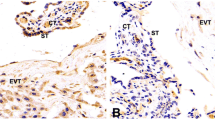Summary
To investigate the expression of osteopontin (OPN) and its receptor integrin ανβ3 in the placental tissue from pregnant women complicated with preeclampsia, the expression of OPN and ανβ3 in the placenta of the pregnant women with preeclampsia and healthy pregnant women was detected by immunohistochemistry, Western blotting and RT-PCR. Our results showed that OPN and ανβ3 protein were expressed in the placenta from normal pregnant woman and those with preeclampsia. OPN was located in the placental syncytiotrophoblasts and the cytoplasm of capillary endothelial cells and integrin ανβ3 was mainly expressed on the surface of trophoblast cells. Expression of OPN and integrin ανβ3 in the placental tissue from preeclampsia subjects was significantly lower than that from the control group (P<0.05). Compared with the control group, expression of OPN in the placental tissue from preeclampsia group was significantly lower (P<0.05) but there was no significant difference in the expression of αν and β3 between the preeclampsia group and the controls. It is concluded that OPN and its receptor integrin ανβ3 may be involved in the pathogenesis of preeclampsia.
Similar content being viewed by others
References
Redman CW, Sargent IL. Latest advances in underst-anding preeclampsia. Science, 2005,308(5728):1592–1594
Sibai B, Dekker G, Kupferminc M. Pre-eclampsia. Lancet, 2005,365(9461):785–799
Wang Y, Chen B, Shen D, Xue S. Osteopontin protects against cardiac ischemia-reperfusion injury through late preconditioning. Heart Vessels, 2009,24(2):116–123
Shui HA, Ka SM, Yang SM, et al. Osteopontin as an injury marker expressing in epithelial hyperplasia lesions helpful in prognosis of focal segmental glomerulosclerosis. Transl Res, 2007,150(4):216–222
Johnson GA, Burghardt RC, Joyce MM, et al. Osteopontin expression in uterine stroma indicates a decidualization-like differentiation during ovine pregnancy.Biol Reprod, 2003,68(6):1951–1958
Apparao KB, Illera MJ, Beyler SA, et al. Regulated expression of osteopontin in the peri-implantation rabbit uterus. Biol Reprod, 2003,68(5):1484–1490
Denhardt DT, Noda M, O’Regan AW, et al. Osteopontin as a means to cope with environmental insults: regulation of inflammation, tissue remodeling, and cell survival. J Clin Invest, 2001,107(9):1055–1061
Johnson GA, Burghardt RC, Bazer FW, et al. Osteopontin: roles in implantation and placentation. Biol Reprod, 2003, 69(5):1458–1471
Briese J, Oberndorfer M, Patschenik C, et al. Osteopontin is colocalized with the adhesion molecule CEACAM1 in the extravillous trophoblast of the human placenta and enhances invasion of CEACAM1-expressing placental cells. J Clin Endocrinol Metab, 2005,90(9):5407–5413
Johnson GA, Burghardt RC, Joyce MM, et al. Osteopontin is synthesized by uterine glands and a 45-kDa cleavage fragment is localized at the uterine-placental interface throughout ovine pregnence. Biol Reprod, 2003,69(1): 92–98
LE Jie. Gynecology and obstetrics. 6th ed. Beijing: People’s Medical Publishing House, 2004:97–106
Chakraborty C, Gleeson LM, McKinnon T, et al. Regulation of human trophoblast migration and invasiveness. Can J Physiol Pharmacol, 2002,80(2): 116–124
Prefumo F, Sebire NJ, Thilaganathan B. Decreased endovascular trophoblast invasion in first trimester pregnancies with high-resistance uterine artery Doppler indices. Hum Reprod, 2004,19(1):206–209
Moon KC, Park JS, Norwitz ER, et al. Expression of extracellular signal-regulated kinase1/2 and p38 mitogen-activated protein kinase in the invasive trophoblasts at the human placental bed. Placenta, 2008, 29(5):391–395
Matthiesen L, Berg G, Ernerudh J, et al. Immunology of preeclampsia. Chem Immunol Allergy, 2005,89:49–61
Winn VD, Gormley M, Paquet AC, et al. Severe preeclampsia-related changes in gene expression at the maternal-fetal interface include sialic acid-binding immunoglobulin-like lectin-6 and pappalysin-2. Endocrinology, 2009,150(1):452–462
Franchi A, Zaret J, Zhang X, et al. Expression of immunomodulatory genes, their protein products and specific ligands/receptors during the window of implantation in the human endometrium. Mol Hum Reprod, 2008,14(7):413–421
Roberts JM, Hubel CA. Oxidative stress in preeclampsia. Am J Obstet Gynecol, 2004,190(5): 1177–1178
Robillard PY, Chaouat G, Le Bouteiller P, et al. Current debates on immunology of preeclampsia. Report of the sixth international workshop of Reunion Island (Indian Ocean, December 2008). Gynecol Obstet Fertil, 2009, 37(6):570–578
Moreau P, Contu L, Alba F, et al. HLA-G gene polymorphism in human placentas: possible association of G*0106 allele with preeclampsia and miscarriage. Biol Reprod, 2008,79(3):459–467
Ward K. Searching for genetic factors underlying pre-eclampsia: recent progress and persistent challenges. Minerva Ginecol, 2008,60(5):399–419
Zhang Z, Jia LT, Zhang LL. Polymorphism of HLA-A and HLA-B in pre-eclampsia. Beijing Da Xue Xue Bao (Chinese), 2009,41(4):418–425
Bdolah Y, Karumanchi SA, Sachs BP. Recent advances in understanding of preeclampsia. Croat Med J, 2005,46(5): 728–736
Roberts JM, Gammill HS. Preeclampsia: Recent insights. Hypertension, 2005,46(6):1243–1249
Liu Q, He J, Dong M Y, et al. Significance of increased level of serum macrophage colony-stimulating factor in patients with preeclampsia. J Zhejiang Unive [Med Sci], 2005,34(6):492–494
O’Regan, AW, Nau GJ, Chupp GL, et al. Osteopontin (Eta-1) in cell-mediated immunity: teaching an old dog new tricks. Immunol Today, 2000, 21(10):475–478
Ashkar S, Weber GF, Vassiliki Panoutsakopoulou V, et al. Eta-1 (osteopontin): an early component of type-1 (cell-mediated) immunity. Science, 2000,287(5454): 860–864
Philip S, Bulbule A, Kundu GC. Matrix metallop-roteinase-2: Mechanism and regulation of NF-kappaB-mediated activation and its role in cell motility and ECM-invasion. Glycoconj J, 2004,21(8–9): 429–441
Raffetto JD, Khalil RA. Matrix metalloproteinases and their inhibitors in vascular remodeling and vascular disease. Biochem Pharmacol, 2008,75(2):345–359
Lockwood CJ, Oner C, Uz YH, et al. Matrix metalloproteinase 9 (MMP9) expression in preeclamptic decidua and MMP9 induction by tumor necrosis factor alpha and interleukin 1 beta in human first trimester decidual cells. Biol Reprod, 2008,78(6):1064–1072
Wang YL. Abnormal Implantation and Pathogenesis of Pre-eclampsi. J, Med Mol Biol, 2006,3(2):85–89
Author information
Authors and Affiliations
Additional information
This project was supported by a grant from Shenzhen Municipal Science and Technology Program (No. 200802107) and a grant for medical research programs from the Health Department of Guangdong Province (No. A2009593).
Rights and permissions
About this article
Cite this article
Xia, J., Qiao, F., Su, F. et al. Implication of expression of osteopontin and its receptor integrin ανβ3 in the placenta in the development of preeclampsia. J. Huazhong Univ. Sci. Technol. [Med. Sci.] 29, 755–760 (2009). https://doi.org/10.1007/s11596-009-0617-z
Received:
Published:
Issue Date:
DOI: https://doi.org/10.1007/s11596-009-0617-z




